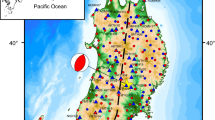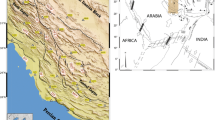Abstract
We invert InSAR from ascending and descending passes of ENVISAT/ASAR data to estimate the distribution of coseismic slip for the 2008 Mw 7.2 Yutian earthquake by separately using uniform finite element models (FEMs), non-uniform FEMs, and analytical elastic half-space (Okada) models. We use the Steepest Descent method and Laplacian smoothing to regularize and estimate the slip distribution for each of these different models. Fault surface ruptures interpolated from Quickbird optical images constrain the strike of the fault. The uniform FEM and Okada models assume a fault embedded in a homogeneous and elastic finite domain or half-space, respectively, while the non-uniform FEM describes a domain with spatially variable elastic properties according to the geological structure of Tibet plateau and Tarim. We find that the estimated slip distribution of the non-uniform FEM is similar to that of the uniform FEM but has a slightly larger moment (~2 %). However, more noticeable discrepancies occur between the slip distributions of the uniform FEM and Okada model, where the slip pattern estimated with the FEM looks more scattered and locates at a lower depth. We conclude that, for the case of the Yutian earthquake, the improvement brought by simulating the distribution of geologic material properties is insignificant. This suggests that the uniform geologic structure of Okada models may be sufficient for simulating large intra-continental earthquakes.









Similar content being viewed by others
References
China Seismological Bureau (1992) The Altun active fault zone. China Seismological Press, Beijing, pp 1–319
Chlie M, Avouac JP, Hjorleifsdottir V, Song TRA, Ji C, Sieh K, Sladen A, Hebert H, Prawirodirdjo L, Bock Y (2007) Coseismic slip and afterslip of the great Mw 9.15 Sumatra–Andaman earthquake of 2004. Bulletin of the Seismological Society of America 97:S152
Christensen N (1996) Poisson's ratio and crustal seismology. J Geophys Res 101:3139–3156
Currenti, G, Del Negro C, Scandura D, Williams CA (2008) Automated procedure for InSAR data inversion using finite element method. In: Use of remote sensing techniques for monitoring volcanoes and seismogenic areas. USEReST 2008. Second Workshop, 1–5. Nov. 2008
Elliott J, Walters R, England P, Jackson J, Li Z, Parsons B (2010) Extension on the Tibetan plateau: recent normal faulting measured by InSAR and body wave seismology. Geophys J Int 183:503–535
Fialko Y (2006) Interseismic strain accumulation and the earthquake potential on the southern San Andreas fault system. Nature 441:968–971
Grilli ST, Harris JC, Tajalibakhsh T, Masterlark TL, Kyriakopoulos C, Kirby JT, Shi F (2012) Numerical simulation of the 2011 Tohoku tsunami based on a new transient FEM co-seismic source. Pure and Applied Geophysics, in press
Guerrieri L, Baer G, Hamiel Y, Amit R, Blumetti A, Comerci V, Di Manna P, Michetti A, Salamon A, Mushkin A (2010) InSAR data as a field guide for mapping minor earthquake surface ruptures: ground displacements along the Paganica Fault during the 6 April 2009 L'Aquila earthquake. J Geophys Res 115:B12331
Hayes G, Briggs R, Sladen A, Fielding E, Prentice C, Hudnut K, Mann P, Taylor F, Crone A, Gold R (2010) Complex rupture during the 12 January 2010 Haiti earthquake. Nat Geosci 3:800–805
Hearn EH, Burgmann R (2005) The effect of elastic layering on inversions of GPS data for coseismic slip and resulting stress changes: strike–slip earthquakes. Bull Seismol Soc Am 95:1637–1653
Hu Y, Wang K, He J, Klotz J, Khazaradze G (2004) Three-dimensional viscoelastic finite element model for postseismic deformation of the great 1960 Chile earthquake. J Geophys Res 109:B12403
Jonsson S, Zebker H, Segall P, Amelung F (2002) Fault slip distribution of the 1999 Mw 7.1 Hector Mine, California, earthquake, estimated from satellite radar and GPS measurements. Bull Seismol Soc Am 92:1377–1389
Masterlark T (2003) Finite element model predictions of static deformation from dislocation sources in a subduction zone: sensitivities to homogeneous, isotropic, Poisson-solid, and half-space assumptions. J Geophys Res 108(B11):2540
Masterlark T, Hughes K (2008) Next generation of deformation models for the 2004 M9 Sumatra–Andaman earthquake. Geophys Res Lett 35:L19310
Masterlark T, Lu Z (2004) Transient volcano deformation sources imaged with interferometric synthetic aperture radar: application to Seguam Island, Alaska. J Geophys Res 109:B01401
Masterlark T, DeMets C, Wang H, Sanchez O, Stock J (2001) Homogeneous vs heterogeneous subduction zone models: coseismic and postseismic deformation. Geophys Res Lett 28:4047–4050
Melosh H, Raefsky A (1981) A simple and efficient method for introducing faults into finite element computations. Bull Seismol Soc Am 71:1391–1400
Molnar P, Burchfiel B, K'uangyi L, Ziyun Z (1987) Geomorphic evidence for active faulting in the Altyn Tagh and northern Tibet and qualitative estimates of its contribution to the convergence of India and Eurasia. Geology 15:249
Okada Y (1985) Surface deformation due to shear and tensile faults in a half-space. Bull Seismol Soc Am 75:1135–1154
Okada Y (1992) Internal deformation due to shear and tensile faults in a half-space. Bull Seismol Soc Am 82:1018–1040
Pollitz FF (1996) Coseismic deformation from earthquake faulting on a layered spherical earth. Geophys J Int 125:1–14
Qiusheng L, Rui G, Deyuan L, Jingwei L, Jingyi F, Zhiying Z, Wen L, Yingkang L, Quanren Y, Dexing L (2002) Tarim underthrust beneath western Kunlun: evidence from wide-angle seismic sounding. J Asian Earth Sci 20:247–253
Rybicki K (1971) The elastic residual field of a very long strike–slip fault in the presence of a discontinuity. Bull Seismol Soc Am 61:79–92
Savage J (1987) Effect of crustal layering upon dislocation modeling. J Geophys Res 92:10595–10600
Savage J (1998) Displacement field for an edge dislocation in a layered half-space. J Geophys Res 103:2439–2446
Schmidt D, Burgmann R (2006) InSAR constraints on the source parameters of the 2001 Bhuj earthquake. Geophys Res Lett 33:L02315
Shan X, Zhang G, Wang C, Qu C, Song X, Guo L (2010) Source characteristics of the Yutian earthquake in 2008 from inversion of the co-seismic deformation field mapped by InSAR. J Asian Earth Sci 40:935–942
Shao XZ, Xu SB (1997) Crust structural characteristics of Tarim basin. Pet Explor Dev 24:1–5
Shen F, Royden L, Burchfiel B (2001) Large-scale crustal deformation of the Tibetan plateau. J Geophys Res 106:6793–6816
Shen ZK, Sun J, Zhang P, Wan Y, Wang M, Burgmann R, Zeng Y, Gan W, Liao H, Wang Q (2009) Slip maxima at fault junctions and rupturing of barriers during the 2008 Wenchuan earthquake. Nat Geosci 2:718–724
Smith AT (1974) Time‐dependent strain accumulation and release at island arcs: implications for the 1946 Nankido earthquake. Dissertation, Massachusetts Institute of Technology, Cambridge, p 292
Sun J, Shi Y, Shen Z, Xu X, Liang F (2007) Parameter inversion of the 1997 Mani earthquake from INSAR co-seismic deformation field based on linear elastic dislocation model. Chin J Geophys 50:1390–1397
Trasatti E, Kyriakopoulos C, Chini M (2011) Finite element inversion of DInSAR data from the Mw 6.3 L'Aquila earthquake, 2009 (Italy. Geophys Res Lett 38:L08306
Wallace K, Yin G, Bilham R (2004) Inescapable slow slip on the Altyn Tagh fault. Geophys Res Lett 31:L09613
Wang H (2000) Theory of linear poroelasticity: with applications to geomechanics and hydrogeology. Princeton University Press, Princeton, p 287
Wang C, Shan X, Zhang G, Guo L, Han Y (2009) Finite element method to invert coseismic slip of Yutian earthquake from InSAR. In Proc SPIE 7841:78410L
Wang C, Ding X, Shan X, Zhang L, Jiang M (2012) Slip distribution of the 2011 Tohoku earthquake derived from joint inversion of GPS, InSAR and seafloor GPS/acoustic measurements. J Asian Earth Sci 57:5128–136. doi:10.1016/j.jseaes.2012.06.019
Wegmuller U, Werner C (1997) Gamma SAR processor and interferometry software. ESA SP-414:1687–1692
Wright TJ, Lu Z, Wicks C (2003) Source model for the Mw 6.7, 23 October 2002, Nenana Mountain earthquake (Alaska) from InSAR. Geophys Res Lett 30:1974
Wright TJ, Lu Z, Wicks C (2004) Constraining the slip distribution and fault geometry of the Mw 7.9, 3 November 2002, Denali fault earthquake with interferometric synthetic aperture radar and global positioning system data. Bull Seismol Soc Am 94:S175
Zhang P, Molnar P, Xu X (2007) Late Quaternary and present-day rates of slip along the Altyn Tagh Fault, northern margin of the Tibetan plateau. Tectonics 26:TC5010
Zhang G, Qu C, Shan X, Song X, Wang C, Hu JC, Wang R (2011) Slip distribution of the 2008 Wenchuan Ms 7.9 earthquake by joint inversion from GPS and InSAR measurements: a resolution test study. Geophys J Int 186:207–220
Zhao S, Muller R, Takahashi Y, Kaneda Y (2004) 3-D finite-element modelling of deformation and stress associated with faulting: effect of inhomogeneous crustal structures. Geophys J Int 157:629–644
Acknowledgments
This work was supported by the National Science Foundation (40874006), Basic Scientific Funding of Institute of Geology, China Earthquake Administration (LED2008A06), and Projects in the National Science & Technology Pillar Program (2008BAC35B04). Support for TM is provided, in part, by the US NSF EAR-0911466. We also thank Dr. Wang Rongjiang for providing SDM code and Prof. Zhang Jingfa for providing the ascending-pass ENVISAT/ASAR data. Academic licensing for Abaqus software is provided by Simulia, Dassault Systèmes.
Author information
Authors and Affiliations
Corresponding author
Rights and permissions
About this article
Cite this article
Wang, C., Shan, X., Wang, C. et al. Using finite element and Okada models to invert coseismic slip of the 2008 Mw 7.2 Yutian earthquake, China, from InSAR data. J Seismol 17, 347–360 (2013). https://doi.org/10.1007/s10950-012-9324-5
Received:
Accepted:
Published:
Issue Date:
DOI: https://doi.org/10.1007/s10950-012-9324-5




